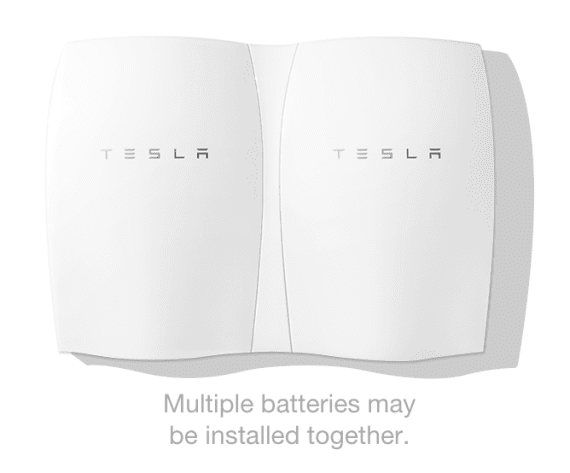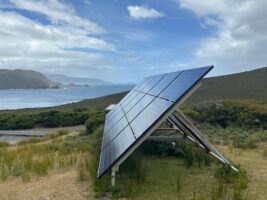(Editor’s note: This story applies to US pricing).
Since the Tesla Powerwall news came out, it seems the world has been racing to understand energy storage. It’s easy to understand the concept of storing electricity and using it at a later point in time. We’ve all been living with batteries of various sorts essentially our whole lives.
However, understanding what the purchase price means in relation to how much electricity the Tesla Powerwall will store and how much that will affect our electricity bills is a new endeavor for many. Additionally, understanding how Tesla’s utility-scale battery offering competes with top players on the market is a mystery to many.
The other day, some other curious people and I ran numbers comparing the per-kWh price of the Tesla Powerwall & what I’m going to call Powerblocks (the utility-scale battery options described on the bottom of this page) with top competitors on the market. Admittedly, that was too simplistic a comparison.
The kWh rating provided for all of these products is simply the maximum amount of electricity they can store at one point in time. So, in the case of the Powerwall, 7 kWh means that the battery can hold up to 7 kWh of electricity at one time, similar to how a 5-gallon jug of water can hold up to 5 gallons of water.
You have to multiply that capacity rating by # of cycles (# of times the battery will be filled up and then emptied), depth of discharge (whether the battery can be fully emptied during each cycle or needs to be only 80% emptied, 70% emptied, etc), and efficiency (how much electricity is actually transmitted, not lost, in each cycle), and then divide by price to determine a per-kWh price for all of the kilowatt-hours your system is expected to produce… before degrading to 80% of its rated capacity, that is (at which point it’s actually still useful, but that’s apparently the global standard for “end of product life”).
As you can see, there are a number of assumptions you have to make to perform these calculations, and even if all of your assumptions are correct, it’s not like the products are completely dead at the end of the studied time period. This also leaves out operational costs (which we’ll assume to be $0 in the calculations below).
Anyhow, this is the best method I’ve found for comparing Tesla’s Powerwall and Powerblocks to top products on the market. More importantly, on the residential side, the numbers should help a consumer to evaluate the cost-effectiveness of getting a Powerwall (should you get commercial access to one) — that’s the main aim in the next section of this article.
Note that I’ve actually left out “competing” lithium-ion and lead-acid batteries in the residential section. Basically, even at a glance, it’s clear that they don’t compete with the Powerwall, so I didn’t bother finding all of the specs and doing the calculations. If you want to do so for any particular battery, I’m happy to add the info in, but I’ll need links or company spec sheets indicating cycle life, expected DoD, efficiency, and price in order to do so.
With a ridiculous amount of help from three wonderful CleanTechnica readers, below are the assumptions and results, split into a “residential” section and a “utility-scale” section.
Residential Battery Storage — Tesla Powerwall x 4 vs Aquion Energy x 2 vs Iron Edison x 1
Subheading have you confused? I ran the numbers for 4 Powerwall purchase scenarios, 2 Aquion Energy products, and 1 Iron Edison product. Since the intro above was too long already, I’ll jump into the table first and list some of the takeaways and the assumptions underneath it:
| Powerwall (cash purchase from SolarCity) | Powerwall (9-year lease from SolarCity) | Powerwall (wholesale cash purchase Tesla) | Powerwall (retail purchase from distributor) | Aquion Energy S20P | Aquion Energy M100-L082P | Iron Edison 24V Lithium Battery | |
| Cycles | 5,000 | 3,285 | 5,000 | 5,000 | 3,000 | 3,000 | 2,000 |
| kWh/cycle (efficiency & degradation assumptions included in calcs) | 5.80 | 5.80 | 5.80 | 5.80 | 1.81 | 21.73 | 2.76 |
| Total kWh produced over product lifetime | 28,980 | 19,040 | 28,980 | 28,980 | 5,430 | 65,178 | 5,530 |
| Total Cost | $7,140 | $5,000 | $3,000 | $3,600 | $1,155 | $15,795 | $2,761 |
| $/kWh used | $0.25 | $0.26 | $0.10 | $0.12 | $0.21 | $0.24 | $0.50 |
What do the “$/kWh used” figures actually mean on a practical level? Here are some examples, just using the final figure from the first Powerwall column:
- If you buy electricity from the grid for $0.35/kWh (with no unavoidable fixed costs) and generate excess electricity from your solar panels that you can’t sell back to the grid, you can save $0.10/kWh by purchasing a Powerwall from SolarCity for $5,000.
- If you buy electricity from the grid for $0.35/kWh (with $0.10/kWh unavoidable fixed costs) and generate excess electricity from your solar panels that you can’t sell back to the grid, you break even by purchasing a Powerwall from SolarCity for $5,000… but are using more of your own solar electricity and relying less on electricity from the grid.
- If you buy electricity from the grid for $0.35/kWh and are not allowed to send any electricity from rooftop solar panels into the grid, and you would generate that electricity at a cost of $0.15/kWh, you would essentially pay $0.05/kWh more by purchasing a Powerwall from SolarCity for $5,000 (but you’d perhaps have to have another source of backup in winter if you don’t have much sunshine then, but you’d be protected against rising grid electricity rates).
- If you buy electricity from the grid for $0.15/kWh (with $0.05/kWh unavoidable fixed costs) and generate excess electricity from your solar panels that you can sell back to the grid for $0.15/kWh, you pay $0.25/kWh more by purchasing a Powerwall from SolarCity for $5,000… but are using more of your own solar electricity and relying less on electricity from the grid.
- If you buy electricity from the grid for $0.15/kWh in the middle of the day (with no unavoidable fixed costs), buy 5.8 kWh of electricity from the grid for $0.40/kWh in the evening each day, and generate excess electricity from your solar panels that you can sell back to the grid for $0.15/kWh or store for later use, you break even by purchasing a Powerwall from SolarCity for $5,000… but are using more of your own solar electricity and relying less on electricity from the grid.
As you can see, the financial benefit depends a great deal on individual circumstances related to your local utility and solar power options. If you are considering a Powerwall (or a product from Aquion Energy or Iron Edison), hopefully this helps you to make a decision.
Assumptions used above:
- Powerwall: 92% efficiency, capacity = average of 90% rated 7 kWh over product life (due to assumed degradation over time), 5,000 cycles before degrading to 80% of rated capacity (theoretical “end of product life”). Also, SolarCity prices come from statements from SolarCity, the wholesale price comes from Tesla Energy, and the retail price from a distributor includes an assumed 20% markup.
- Aquion Energy S20P: 85% efficiency, capacity = average of 90% rated 2.366 kWh over product life (due to assumed degradation over time), 3,000 cycles before degrading to 80% of rated capacity (theoretical “end of product life”). Price from retailer linked above (and seems to be on sale).
- Aquion Energy M100-L082P: 85% efficiency, capacity = average of 90% rated 28.4 kWh over product life (due to assumed degradation over time), 3,000 cycles before degrading to 80% of rated capacity (theoretical “end of product life”). Price from retailer linked above (and seems to be on sale). Admittedly, far larger than most homes would need — more appropriate for some businesses.
- Iron Edison 24V Lithium Battery: 96% efficiency, capacity = average of 90% rated 4 kWh over product life (due to assumed degradation over time), 2,000 cycles before degrading to 80% of rated capacity (theoretical “end of product life”), 80% depth of discharge. Price from retailer linked above.
Utility-Scale Battery Storage — Tesla Powerblock vs Eos Aurora vs Imergy Flow Battery
Before jumping into this table, let me note that the Eos Aurora battery isn’t supposed to be available until 2016. Also, when it comes to Imergy, it has states a current price of $500/kWh (capacity) and a projected future price of $300/kWh (capacity), so I’ve run numbers for both. It’s not clear when Imergy expects to reach $300/kWh from what I’ve read.
Lastly, Imergy’s vanadium flow batteries reportedly have “unlimited” ability to cycle (no degradation like with the other batteries here), but the warranty period is just 5-10 years. So, in two examples, I give Imergy a product lifetime of 15 years (same as with Tesla, which offers a 10-year warranty but projects a 15-year lifespan) and 30 years. Whether a utility or other business customer is going to consider the cost over 30 years or bet on such a lifespan is a question to consider.
| Powerblock (utility) | Eos Aurora 1000 | 6000 | Imergy (current pricing, 15 years of life) | Imergy (current pricing, 30 years of life) | Imergy (projected pricing, 15 years of life) | Imergy (projected pricing, 30 years of life) | |
| Cycles | 5,000 | 10,000 | 5,475 | 10,950 | 5,475 | 10,950 |
| kWh/cycle (efficiency & degradation assumptions included in calcs) | 8,280 | 4,050 | 7,500 | 7,500 | 7,500 | 7,500 |
| Total kWh produced over product lifetime | 41,400,000 | 40,500,000 | 41,062,500 | 82,125,000 | 41,062,500 | 82,125,000 |
| Total Cost | $2,070,000 | $648,000 | $3,750,000 | $3,750,000 | $2,250,000 | $2,250,000 |
| $/kWh used | $0.05 | $0.02 | $0.09 | $0.05 | $0.05 | $0.03 |
As you can see, the assumptions here are quite critical to determining the lowest-cost product. Will startup Eos Energy deliver as promised? Will Imergy’s battery work and be useful to you for 30 years? Will Imergy’s cost come down to $300/kWh as projected? Will Tesla’s Powerblock last 5,000 cycles and cost $250/kWh?
I imagine some utilities are going to hedge their bets a bit and buy various storage products. And I imagine other utilities will just go for the products that they most trust or prefer for their specific needs.
Of course, there are many other battery-storage companies on the market and winning contracts, as well as some reportedly coming to market in the coming year, but I couldn’t find prices or important specs for them so they were not included above. Such companies include Alevo, AES, Bosch, CODA Energy, EnerVault, and many more.

Assumptions used in the table above:
- Tesla Powerblock: 92% efficiency, capacity = average of 90% rated 10 MWh (example) over product life (due to assumed degradation over time), 5,000 cycles before degrading to 80% of rated capacity (theoretical “end of product life”), $250/kWh.
- Eos Aurora 1000 | 6000: 75% efficiency, capacity = average of 90% rated 6 MWh (example) over product life (due to assumed degradation over time), 10,000 cycles before degrading to 80% of rated capacity (theoretical “end of product life”), $160/kWh.
- Imergy Vanadium Flow Battery: 75% efficiency, capacity = 100% of rated 7.5 MWh, 5,475 cycles over 15-year lifespan or 10,950 cycles over 30-year lifespan (it could also cycle twice a day, in which case the 30-year examples could apply to 15 years), $500/kWh current pricing and $300/kWh projected future pricing.
Source: CleanTechnica. Reproduced with permission.















